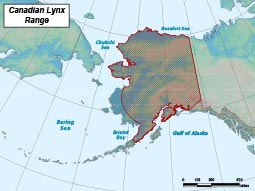Lynx
(Lynx Canadensis)
Species Profile
Did You Know?
“Link” is a common local term for lynx in Alaska and the Yukon.
General Description
The lynx is a large, short-tailed cat, similar to the bobcat, but distinguished by its long legs, furry feet, the long tufts on the tip of each ear, and a black-tipped tail. The large broad feet function as snowshoes to aid the lynx in winter hunting and traveling. The dense soft fur is buffy grey with indistinct spotting. Most adults weigh from 18 to 30 pounds (8.2–13.6 kg). Male lynx are generally larger than females and occasionally weigh 40 pounds (18.2 kg) or more.
Life History
Growth and Reproduction
Mating occurs in March and early April and kittens are born about 63 days later under a natural shelter such as a spruce felled by wind, a rock ledge, or a log jam. Lynx kittens resemble domestic cats at birth and are buff colored with longitudinal streaking on their backs. Their eyes open about 1 month of age, and they are weaned when 2–3 months old. Most litters include two to four kittens, but sometimes as many as six are born and survive.
The production and survival of lynx kittens is strongly influenced by cyclic changes in snowshoe hare and other small game populations. When prey are abundant, a high percentage of 1-year old or older female lynx produce kittens, most of which survive. When prey is scarce, very few yearlings breed, the number of breeding adults declines, and very few kittens survive until winter.
Kittens remain with their mother until late winter and acquire the hunting skills and knowledge necessary for their survival. During the following breeding season, family units begin to break up.
Behavior
Lynx normally travel one to five miles per day within home ranges ranging from five to more than 100 square miles. The largest ranges occur when prey are scarce. Lynx travel and hunt at a walk most of the time and capture their prey with short bursts of speed. They often ambush hares and other small prey while bedded down near small game trails. Lynx are adept at climbing trees but hunt mainly on the ground, sometimes using trees as a refuge from larger predators such as wolves.
Lynx are curious animals and are fairly easy to trap using lures made from beaver castor, catnip, or other scents. Visual attractors such as bird wings or aluminum foil are often used to take advantage of the lynx's visual acuity.
Feeding Ecology
The primary prey of lynx in most areas is the snowshoe hare, which undergoes an 8–11 year cycle of abundance. This cycle appears to be caused by the interaction of hares with their food and predators. Lynx numbers fluctuate with those of hares and other small game, but lag one or two years behind. When a hare population crashes, lynx numbers soon decline because of the small number of kittens reaching adulthood and the movement of some lynx out of the area. In recent studies of radio-collared lynx in Canada, Minnesota, and Alaska, movements of from 100 to 400 miles or more have been documented as lynx left areas where hares had become scarce. For example, a radio-collared lynx from the southern Yukon traveled over 400 miles to Chalkyitsik, Alaska, on the Yukon Flats.
Although snowshoe hares are an important prey for lynx, when they are scarce lynx use other food sources more extensively, and other small prey such as grouse, ptarmigan, squirrels, and microtine rodents are regularly taken. Lynx are also known to prey on caribou, Dall sheep, and foxes, especially during periods of snowshoe hare scarcity.
Range and Habitat
Lynx inhabit much of Alaska's forested terrain and use a variety of habitats, including spruce and hardwood forests, and both subalpine and successional communities. The best lynx habitat in Alaska occurs where fires or other factors create and maintain a mixture of vegetation types with an abundance of early successional growth. This provides the best habitat for snowshoe hares and other small prey of lynx.
Lynx are not present in southern Southeast Alaska, or on the major islands of Southeast (Admiralty, Baranof and Chichagof), and are considered scarce in northern Southeast Alaska. This mirrors the presence of hares.
Status, Trends, and Threats
Status
Fluctuates cyclically, tied to hare population cycles. They are considered common in the areas where they occur.
Fast Facts
-
Size
Most adults weigh from 18 to 30 pounds -
Distribution
Much of Alaska's forested terrain -
Diet
Hares are the preferred food -
Reproduction
Two to four kittens


